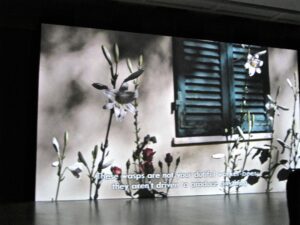My heart sinks as I walk into the preview. It’s a big room and the work doesn’t really visually dominate it. It reminds me of a town planning exhibit. Lots of photos, information, diagrams. The themes are very worthy, mining, colonialism, exploitation. There are some impressive tapestries in glowing colours with some glitter woven in and bold patterns.
I have read of occasions years ago when audiences derided Impressionism or rioted at the first performance of Stravinsky’s ‘Rite of Spring’ Now the audience at a preview at Tate St Ives are so quiet, respectful and loth to react spontaneously that they stand motionless, politely uncomplaining whilst the director and the artist Otobong Nkanga speak in a room so acoustically unsuited to enable people to hear that no one can have understood anything of what has been uttered.
Then they circulate examining everything quite carefully, not willing to commit themselves to an opinion other than that it’s very interesting.
The artist has created something to do with the place and the mining of tin. It’s not the first time we in St

Ives find the latest visiting artist has seized on this theme.
Otobong Nkanga has exhibited in prestigious places and does a lot of research. I feel she wants to say something heartfelt but her mode of expression is so dry, so unpoetic, so dull, that I can’t stomach it. She is there, looking beautiful, wearing a sort of work person’s jumpsuit and in bare feet, talking earnestly. Her tapestries are remarkable, substantial and much the most enjoyable part of her show. Maybe as she goes on, now having got onto the global success circuit, she will find her way and make work that is not simply worthy but that sings.
On the way out I encounter the much less publicised work, a film ‘Children of Unquiet’ by Mikhail Karikis. It’s 15 minutes long and shown in a room with only one short bench so I sit on the floor to get the back support of the wall. Despite these very unfavourable cinematic conditions people are watching rapt with attention. It’s about a disused geothermal energy plant in an Italian village. This doesn’t sound that promising a theme for poetic treatment but it turns out that every frame is beautiful and eloquent, every word of subtitle counts.
There are lovely shots of steaming ground, dripping machinery, cooling towers and orchids. Children are choreographed to shout and stamp or they read out statements about bees or wasps and about love.
I am so very pleased to find something so visually stunning, so all of a piece, so full of meaning and contrasts, so worth re-watching.
Mary Fletcher
Volume 34 no.2 November/December 2019 pp 26-27

That’s a brave review of Otobong Nkanga but somebody has to speak up. In the arts, the one you criticize might be your colleague or department head, or their ally… They say you can’t be a critic without offending 4 people a week.
Related to your comment on Karikis’ work, the Tate Gallery recently published an article saying take your time looking at art, complaining that people rush by the work without really looking. It’s likely that when people rush by a work, perhaps the work’s at fault and not the people. Mikhail Karikis’ video had rapt attention, so that’s the kind of art we need to defend.
Thank you for commenting. I find the main benefit of attending one of the Tate talks that go round the gallery is that it slows me down so that I take in far more.